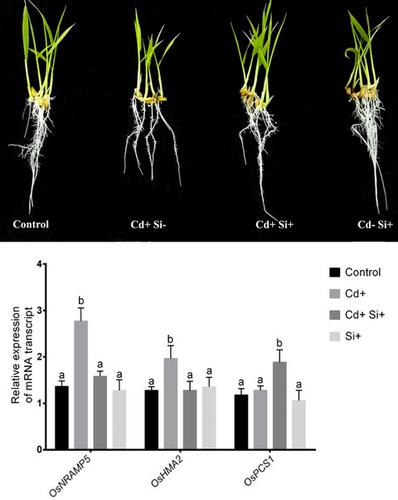当前位置:
X-MOL 学术
›
Plant Biol.
›
论文详情
Our official English website, www.x-mol.net, welcomes your
feedback! (Note: you will need to create a separate account there.)
Silicon induces phytochelatin and ROS scavengers facilitating cadmium detoxification in rice.
Plant Biology ( IF 4.2 ) Pub Date : 2020-02-26 , DOI: 10.1111/plb.13090 M A Bari 1, 2, 3 , S A Prity 2 , U Das 2 , M S Akther 2 , S A Sajib 3 , M A Reza 3 , A H Kabir 2
Plant Biology ( IF 4.2 ) Pub Date : 2020-02-26 , DOI: 10.1111/plb.13090 M A Bari 1, 2, 3 , S A Prity 2 , U Das 2 , M S Akther 2 , S A Sajib 3 , M A Reza 3 , A H Kabir 2
Affiliation

|
Cadmium (Cd) is detrimental to crops and the environment. This work examines the natural mechanisms underlying silicon- (Si-)directed Cd detoxification in rice plants. The addition of Si to plants under Cd stress caused significant improvements in morphological parameters, chlorophyll score, Fv /Fm and total soluble protein concentration compared to controls, confirming that Si is able to ameliorate Cd-induced damage in rice plants. This morpho-physiological evidence was correlated with decreased cell death and electrolyte leakage after Si application. The results showed no critical changes in root Cd concentration, while shoot Cd decreased significantly after Si supplementation in comparison with Cd-stressed rice. Additionally, expression of Cd transporters (OsNRAMP5 and OsHMA2) was significantly down-regulated while the concentration of phytochelatin, cysteine and glutathione, together with expression of OsPCS1 (phytochelatin synthase) in roots of Cd-stressed rice was significantly induced when subjected to Si treatment. This confirms that the alleviation of Cd stress is not only limited to the down-regulation of Cd transporters but also closely related to the phytochelatin-driven vacuolar storage of Cd in rice roots. The enzymatic analysis further revealed the role of SOD and GR enzymes in protecting rice plants from Cd-induced oxidative harm. These findings suggest a mechanistic basis in rice plants for Si-mediated mitigation of Cd stress.
中文翻译:

硅诱导植物螯合素和ROS清除剂,促进水稻中的镉排毒。
镉(Cd)对农作物和环境有害。这项工作研究了水稻中硅(Si-)导向的Cd解毒背后的自然机制。与对照相比,向Cd胁迫下的植物中添加Si可以显着改善形态参数,叶绿素得分,Fv / Fm和总可溶性蛋白浓度,从而证明Si能够缓解Cd诱导的水稻植物伤害。这种形态生理学证据与施用硅后细胞死亡减少和电解质渗漏有关。结果表明,与施Cd的水稻相比,施Si后根Cd浓度无明显变化,而地上Cd显着降低。另外,硅处理后,显着下调了Cd转运蛋白(OsNRAMP5和OsHMA2)的表达,同时显着诱导了Cd胁迫的水稻根系中植物螯合素,半胱氨酸和谷胱甘肽的浓度以及OsPCS1(植物螯合素合酶)的表达。这证实了镉胁迫的缓解不仅限于镉转运蛋白的下调,而且与植物根系驱动液泡中水稻根中镉的储存密切相关。酶促分析进一步揭示了SOD和GR酶在保护水稻免受Cd诱导的氧化伤害中的作用。这些发现暗示了水稻植物中硅介导的镉胁迫缓解的机制基础。硅处理后,显着诱导了镉胁迫水稻根中OsPCS1(植物螯合素合酶)的表达。这证实了镉胁迫的缓解不仅限于镉转运蛋白的下调,而且还与植物根系驱动液泡中水稻根中镉的贮藏密切相关。酶促分析进一步揭示了SOD和GR酶在保护水稻免受Cd诱导的氧化伤害中的作用。这些发现暗示了水稻植物中硅介导的镉胁迫缓解的机制基础。硅处理对镉胁迫水稻根系中OsPCS1(植物螯合素合酶)的表达有明显的诱导作用。这证实了镉胁迫的缓解不仅限于镉转运蛋白的下调,而且与植物根系驱动液泡中水稻根中镉的储存密切相关。酶促分析进一步揭示了SOD和GR酶在保护水稻免受Cd诱导的氧化伤害中的作用。这些发现暗示了水稻植物中硅介导的镉胁迫缓解的机制基础。酶促分析进一步揭示了SOD和GR酶在保护水稻免受Cd诱导的氧化伤害中的作用。这些发现暗示了水稻植物中硅介导的镉胁迫缓解的机制基础。酶促分析进一步揭示了SOD和GR酶在保护水稻免受Cd诱导的氧化伤害中的作用。这些发现暗示了水稻植物中硅介导的镉胁迫缓解的机制基础。
更新日期:2020-02-26
中文翻译:

硅诱导植物螯合素和ROS清除剂,促进水稻中的镉排毒。
镉(Cd)对农作物和环境有害。这项工作研究了水稻中硅(Si-)导向的Cd解毒背后的自然机制。与对照相比,向Cd胁迫下的植物中添加Si可以显着改善形态参数,叶绿素得分,Fv / Fm和总可溶性蛋白浓度,从而证明Si能够缓解Cd诱导的水稻植物伤害。这种形态生理学证据与施用硅后细胞死亡减少和电解质渗漏有关。结果表明,与施Cd的水稻相比,施Si后根Cd浓度无明显变化,而地上Cd显着降低。另外,硅处理后,显着下调了Cd转运蛋白(OsNRAMP5和OsHMA2)的表达,同时显着诱导了Cd胁迫的水稻根系中植物螯合素,半胱氨酸和谷胱甘肽的浓度以及OsPCS1(植物螯合素合酶)的表达。这证实了镉胁迫的缓解不仅限于镉转运蛋白的下调,而且与植物根系驱动液泡中水稻根中镉的储存密切相关。酶促分析进一步揭示了SOD和GR酶在保护水稻免受Cd诱导的氧化伤害中的作用。这些发现暗示了水稻植物中硅介导的镉胁迫缓解的机制基础。硅处理后,显着诱导了镉胁迫水稻根中OsPCS1(植物螯合素合酶)的表达。这证实了镉胁迫的缓解不仅限于镉转运蛋白的下调,而且还与植物根系驱动液泡中水稻根中镉的贮藏密切相关。酶促分析进一步揭示了SOD和GR酶在保护水稻免受Cd诱导的氧化伤害中的作用。这些发现暗示了水稻植物中硅介导的镉胁迫缓解的机制基础。硅处理对镉胁迫水稻根系中OsPCS1(植物螯合素合酶)的表达有明显的诱导作用。这证实了镉胁迫的缓解不仅限于镉转运蛋白的下调,而且与植物根系驱动液泡中水稻根中镉的储存密切相关。酶促分析进一步揭示了SOD和GR酶在保护水稻免受Cd诱导的氧化伤害中的作用。这些发现暗示了水稻植物中硅介导的镉胁迫缓解的机制基础。酶促分析进一步揭示了SOD和GR酶在保护水稻免受Cd诱导的氧化伤害中的作用。这些发现暗示了水稻植物中硅介导的镉胁迫缓解的机制基础。酶促分析进一步揭示了SOD和GR酶在保护水稻免受Cd诱导的氧化伤害中的作用。这些发现暗示了水稻植物中硅介导的镉胁迫缓解的机制基础。











































 京公网安备 11010802027423号
京公网安备 11010802027423号